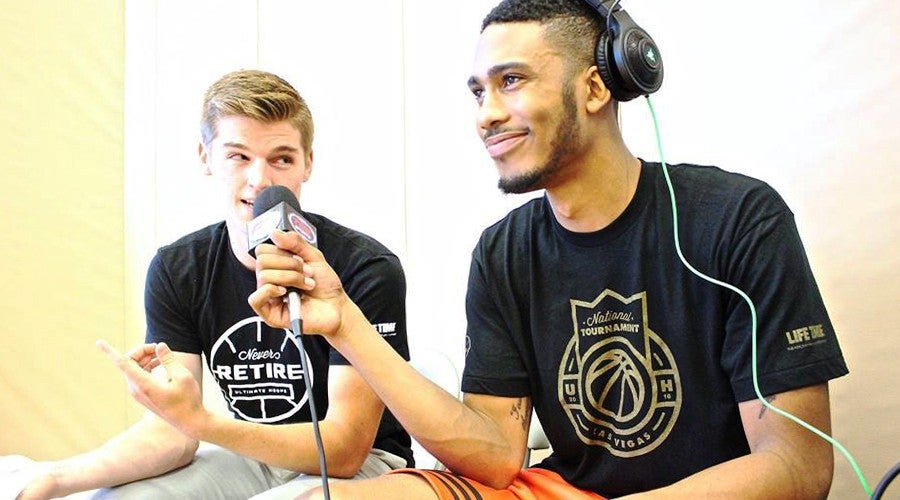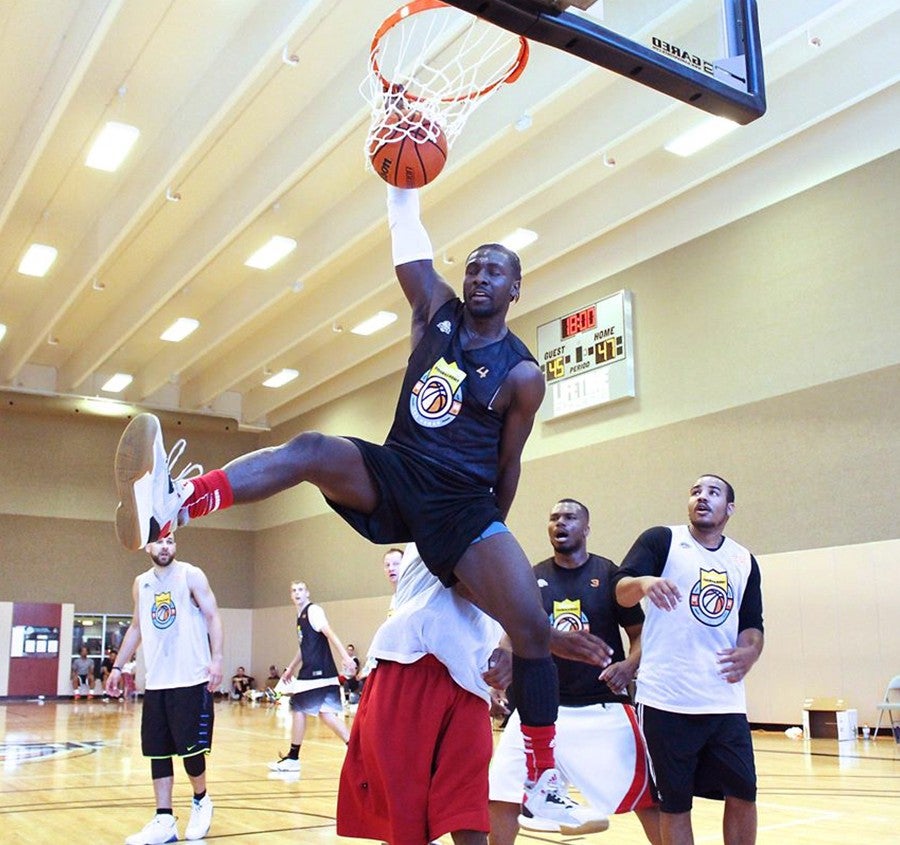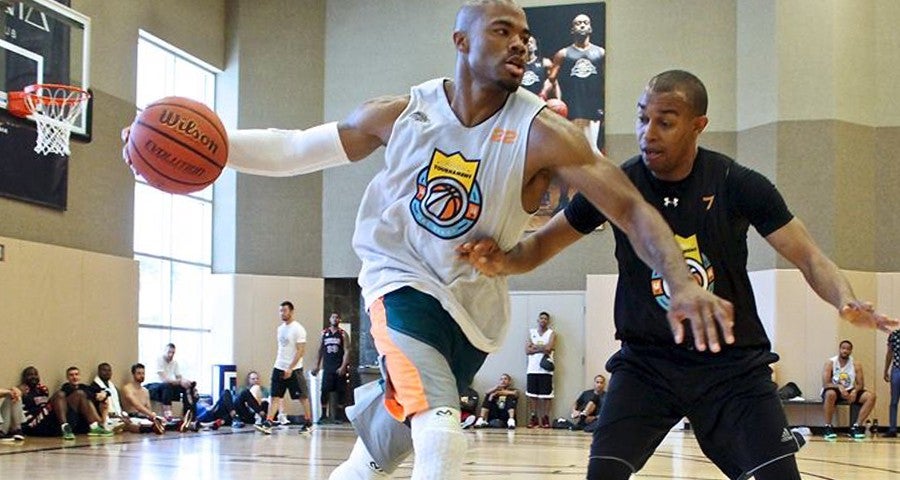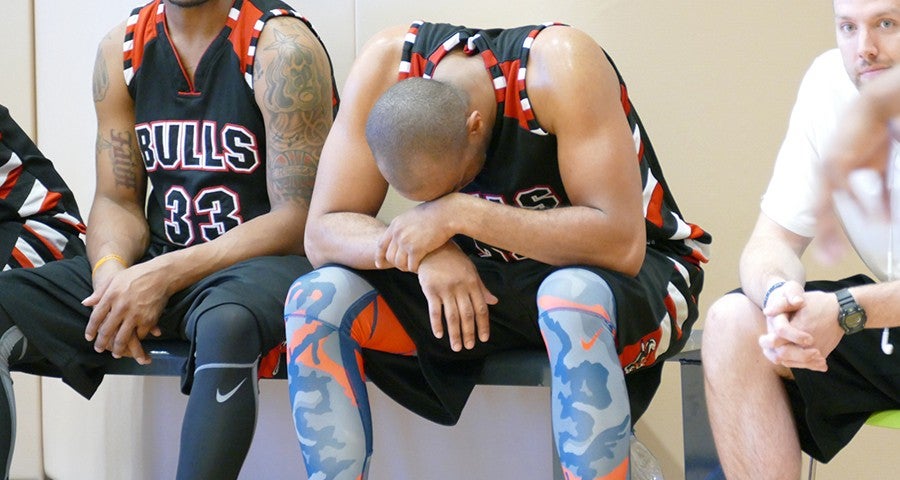Like most things in Las Vegas, the Ultimate Hoops tournament kicks off with a party.
While the DJ spins hip-hop and Top 40, the 150 or so players and their entourages enter on a red carpet to get interviewed for the Ultimate Hoops YouTube channel, after which they settle inside a poolside cabana and enjoy free food and drinks.
“I don’t care who you are, everybody wants to be treated like a celebrity,” says Alan Arlt, the 45-year-old founder of the league, which started in Minnesota in 2006.
The Arizona squad “Ball So Hard,” the 2015 tournament champions, seem to particularly relish their newfound celebrity status. Funded by Baltimore Raven Terrell Suggs (an alum of Arizona State University), they’re impossible to miss when they enter the party in matching shirts. The outfits will eventually give way to custom jerseys for the tournament, which is being held 10 miles off the strip at the Life Time Fitness complex in suburban Henderson. The high-fashion arrival won’t be the only NBA trope emulated here: In-house media will issue stats and personal rankings, conduct post-game interviews and even live-stream the game for those who aren’t able to attend in person.
Most players here are used to the tournament rigor. In their youth, many of them traveled with teams in the Amateur Athletic Union, a feeder league for NCAA and the pros. Others made it as far as to the NCAA, NBA, or other pro sport leagues. This year alone, ex-NBA players Josh Childress (Atlanta Hawks), Jerome “Junkyard Dog” Williams (Detroit Pistons) and Corey Maggette (Los Angeles Clippers) all played on tournament teams, but the majority of players could only dream about making it that far.
“There’s a small amount of people who can play in the NBA, but 20 million people who want to play in the NBA,” says Arlt, who looks more like a marketing manager than a baller — though he does play in league games in Minnesota. He realized the Ultimate Hoops concept had legs after its first attempt at conducting post-game interviews.
“This is the moment when two things could happen,” Arlt explains. “The guy could look at the mic and think, What are you doing putting a microphone in my face at a recreation league basketball game? Get away from me. Or he could start talking about their recreational basketball game like it was Game Seven of the NBA Finals. And that’s what happened. I was driving home that night almost crying. I said to my wife, ‘This is gonna work.’”

The league’s finale is condensed into one 48-hour stretch. Sixteen teams have paid $395 each to compete. Though guys who do it up right can spend close to a grand on their trip, not to mention the cost of bringing a cheering section along for the ride. There is no money in return — not even for the winning team — so the trophy they hope to earn costs them money. Not that they care.
“They’re so passionate about it,” says Dallas league coordinator Brandon Barkley, a 23-year-old who is tall enough that basketball was a foregone conclusion for his college years. “We are the biggest men’s rec league in the country, so by saying you’re the best in Ultimate Hoops, [it means] you’re the best. It’s bragging rights.”
Arlt himself is more stathead than jock. As a child, he was obsessed with Strat-O-Matic’s basketball card game, an early version of fantasy sports that used stats to determined the outcome of hypothetical matchups. “It was my version of Dungeons and Dragons,” he jokes.
After a career in media ad sales in New York, Arlt brought his childhood hobby full circle, moving back home to Minnesota and starting Ultimate Hoops. “We went from five to 40 teams in 18 months.” Not long afterward, Life Time Fitness acquired Ultimate Hoops to make the league available to its members. Soon it had expanded to 2,000 players in 22 cities, who were drawn to Ultimate Hoops’ statistical obsessiveness and pomp and circumstance, above all else — from detailed, searchable stats to a full media complex of recap articles, podcasts and Facebook chatter.
“You have power rankings, you have debate and conversation, you have guys talking trash,” Arlt says. “That builds tighter and tighter bonds.”

The Saturday tournament goes from 9 a.m. to 9 p.m.
“We treat this like the Olympics: Build up the best team from your region and bring them out,” explains Reid Nelson, the organization’s national manager of leagues, from the sidelines.
Despite the fanfare and red carpets, the entire tournament takes place in a single gym, on two side-by-side courts, with games running simultaneously. There’s only one place to sit: a single-file line of chairs that run between the two games, turned to face whichever one holds the viewer’s attention. When the seats are full, spectators crowd by the sidelines, eventually spilling out into the main workout floor in search of some relative quiet and air conditioning. The locals on stairmasters make casual conversation about the bits of play they can see. On the final day, R&B singer Trey Songz, in town for a club appearance, peeks in to watch a few minutes of the semi-finals. The players’ wives, girlfriends and stray groupies barely pay attention to him, their eyes and minds focused completely on the game.
“Every time I come, something happens to him,” says Camille Matos of Colorado, whose husband Carlos works in IT by day and fires threes like Steph Curry at night. “Last time he almost got his eye scratched out!”
No medical emergency befalls Matos this time, though other players aren’t so lucky. During Saturday’s final game, Vegas Ballers player #73 chips a tooth after a hard slam to the ground. Everything pauses until he can retrieve it, then picks back up while he sits out a few minutes to recover.
By the end of Saturday night, only half the teams remain: two from Colorado, two from Minnesota, two from California and one each from Arizona and Las Vegas. A surprise is Rec-City from Minneapolis, the only team in this year’s tournament without a single player who played at either the college or pro level. Izzy Elkaffas, team captain, says while the teams stocked with pros might be more athletic and in better shape, his team can still deliver on pure talent. “We can outwork anyone in this tournament and hopefully get a [win].”
And they do. They beat Vegas’ Villains and narrowly lose in three overtimes to a team from California on day one. While Rec-City are knocked out in the first round of day two by the Vegas Ballers, the game is hard-fought. One player even gets ejected.
When night one wraps up, the Ultimate Hoops staff is loopy with excitement. They film post-event recaps, tidy up the gym and then grab a basketball and start shooting. They decide they won’t leave the gym until someone hits a half-court shot. It takes about four rotations through their shooting order until someone nails it.
Before they leave, they silently parade behind Nelson, who’s shooting his recap video, parodying the Beatles’ Abbey Road cover. Nelson doesn’t blink, and the guys hold their laughter until the gym doors click behind them.

For the players, commitment to the league and its annual national tournament requires extraordinary measures. Kenny Zeigler, a four-year veteran of the tournament from Maryland, had to fly down to Atlanta in the middle of the week to play a qualifying game to claim his spot on a tournament team with the Minnesota Bulls, who make it all the way to the championship game.
“Wherever I was, I was playing pickup,” explains Zeigler, who’s still in impeccable shape. “There was nothing organized or structured about it, but I was trying to find some kind of competition.”
Zeigler played high school ball in Georgia and college ball at Furman University in South Carolina. After kicking around a few semi-pro leagues, he tore his Achilles and settled into a career in marketing. “For a lot of people that kind of injury would end your [career],” he says. “Not a lot of people want to rehab so they can go back and play basketball when [they’re] not getting paid anymore. Luckily, I’ve been able to bounce back.”
He moved to Maryland and found Life Time Fitness when Ultimate Hoops was in its infancy. Normally he plays with a Maryland team, but they didn’t have a team coming for this year’s tournament, so he teamed up with the Minnesota Bulls. His five-month pregnant wife came to the tournament to cheer him on.
“She hasn’t seen me play since college,” he says. “She knows that basketball’s been a huge part of my life. Every Wednesday when we have a league game or a pickup game, she knows to let me have my time.”

In the final, Ball So Hard beats the Bulls 69 to 56. They’d almost been knocked out the game before, down double-digits going into the half against Vegas Ballers, only to turn it around for a 10-point victory. In the Bulls match, there’s debate over the scoreboard, the time-keeping, the referees, but in the end they get a trophy and a post-game interview.
When it’s over, the gym empties with comical speed. Equipment is packed up, shirts are boxed to be sent back to headquarters and the staff huddles to select the best photos for social media before heading off to dinner to keep talking about the event — what could have gone better, what couldn’t have and what next year will bring.
The players, too, are already thinking about next year.
“I say the day I can’t dunk is the day I hang [my sneakers] up,” Zeigler says. “But I don’t see that happening soon anytime soon. We have guys here who are well into their 40s. Once you’re a ballplayer, that’s how you are for life.”
Until then, it’s back to their local leagues to keep chasing the fantasy.
“This accountant who sits in an office every day comes on Thursdays and gets to play against a former NBA star,” Barkley says. “He thinks, ‘I still love basketball. On Thursday night, I’m not Dad; I’m that alter ego on the court.’”
Rae Votta covers the world of digital entertainment for The Daily Dot and writes the newsletter ReadySetGrowup for financial tips. She also writes all about keeping in touch with your finances for MEL.
